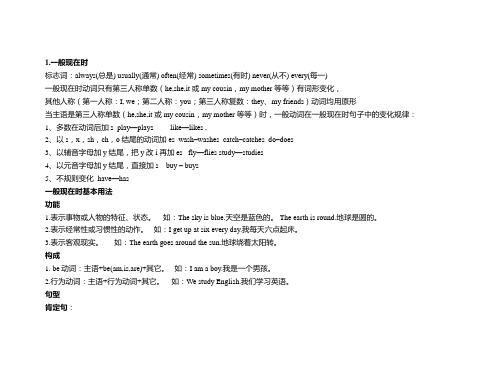牛津英语5A英语语法现在进行时
- 格式:doc
- 大小:19.00 KB
- 文档页数:2

5A Unit6 语法笔记一、现在进行时【be动词(am 、is 、are ) +动词-ing表示动作正在进行】1.如何确定(1)句子前或后有now ,句首有look , listen 时,用现在进行时be +动词-ing.(2)问句用现在进行时,答句也用现在进行时.(3)根据上下文能看出用现在进行时.【例外:】Shall we go now ? 在这句中应根据shall we 来确定用go。
Let’s go now . 在这句中应根据let’s 来确定用go .2.例句(1)I am running我现在正在跑.(2are sweeping the floor in the classroom .看,他们正在教室里扫地. (3is singing in the music room .听,一个女孩在音乐教室里唱歌. (4)Kate , your mother is sleeping ,don’t listen to music ,please.凯特,你妈妈正在睡觉,请不要听音乐了.【注意1、be 动词的正确使用.要和人称一致.2、现在分词的构成见U6的三级训练.】二、句型转换1. 肯定句: I am walking . 我正在散步.否定句: I am not walking .我不在散步.一般疑问句: Are you walking ? 你在散步吗?肯定回答: Yes , I am. 是的.否定回答: No, I’m not .不, 我不在.特殊疑问句: What are you do ing ? 你正在干什么?回答 : I am +动词-ing ./ We are +动词-ing .2. 肯定句: He is walking . 他正在散步.否定句: He is not walking .他不在散步.一般疑问句: Is he walking ? 他在散步吗?肯定回答: Yes , he is . 是的.否定回答: No, he isn’t .不, 他不在.特殊疑问句: What is he do ing ? 他正在干什么?回答 : He is +动词-ing .3. 肯定句: Nancy is walking . 南茜正在散步.否定句: Nancy is not walking .南茜不在散步.一般疑问句: Is Nancy walking ? 南茜在散步吗?肯定回答: Yes , she is . 是的.否定回答: No, she isn’t .不, 她不在.特殊疑问句: What is Nancy do ing ? 南茜正在干什么?回答 : She is +动词-ing .4.肯定句: They are walking . 他们正在散步.否定句: They are not walking .他们不在散步.一般疑问句: Are they walking ? 他们在散步吗?肯定回答: Yes , they are .是的.否定回答:No, they aren’t .不, 他们不在. 特殊疑问句: What are they do ing ? 他们正在干什么?回答 : They are +动词-ing .5.肯定句: We are walking . 我们正在散步.否定句: We are not walking .我们不在散步.一般疑问句: Are you walking ? 你们在散步吗?肯定回答: Yes , we are .是的.否定回答:No, we aren’t .不, 我们不在.特殊疑问句: What are you do ing ? 你们正在干什么?回答 : We are +动词-ing .6.肯定句: Helen and her mother are doing housework. 海伦和她妈妈正在做家务。

Module 1Unit 1 Can II do this?本课重点是现在进行时现在进行是由be+doing构成的。
其中bef动词根据主语作相应变化。
现在进行时的否定形式是be动词后加not.Look and read (On the underground) 栏目中,be going to (正在去某地), be waiting for (正在等候), be not eating and drinking (没在吃和喝),be going out (正在出去) 是现在进行时的用法。
课文中What are they saying? (他们正在说什么?) 是现在进行时的特殊疑问句。
Look and say (At home) 和Ask and answer 栏目是复习操练can 引起的一般疑问句和它的省略回答。
由which 引起的特殊疑问句可以是which作疑问词,也可以由which+名词作疑问词。
例:I have three books. Which (one) do you like? 我有三本书,你喜欢哪一本?Which skirt do you like? 你喜欢哪条裙子?学习目标1. 核心词汇cross v. 横穿mean v. 意思是sign n. 标志smoke V.吸烟station n.车站traffic light 交通灯注意or 意思是“或者”时是转折连词。
例:underground n.地铁which n./adj.哪一个2、其它词汇drink v.喝road n. 马路way n.路线rubbish n.垃圾or conj.或者3. 词汇学习1) station (车站), 同义词stop (车站)。
它们的区别在于station指的大车站,如underground station (地铁站), stop 指小车站, bus stop (公交车站)2) which (哪一个)和what (什么) 都是疑问词, 放在句首构成特殊疑问句.注意,W hich是指“(一定范围中的)哪一个”, what的意思是“什么”,没有范围限制。


牛津五年级英语语法大全(新)深圳牛津版五年级上册五年级英语语法知识汇总一、词类:1、名词这里强调两点:不可数名词都默认为单数,所以总是用i人称代词:有主格和宾格之分。
一般动词前用主格,动词后用宾格。
3、指示代词4、冠词有a、an、the。
a和an的区别:an用于元音音素(一般就是元音字母a、e、i、o、u)前,a用于辅音音素前。
二、否定句:be动词(am、i、are)+not、情态动词can+not、助动词(do、doe)+not如何将一个肯定的陈述句改为否定句:1、看句中有无be动词,如有,直接在be动词后+not。
2、看句中有无情态动词,如有,直接在情态动词后+not。
3、如上述二者都没有,就应用助动词+not。
分四个步骤:深圳牛津版五年级上册(1)肯定陈述句中本来是没有助动词的,要加上去,位置在主语(某人或某物)后,动词前。
(2)确定助动词用do、doe,根据句中动词,动词是原形的助动词就用do,动词是第三人称单数的助动词就用doe,(3)在助动词后加not。
(4)原句中动词假如发生变化就要恢复成原形。
强调一点,有ome的要考虑是否要用any。
三、一般疑问句。
如何将一个肯定的陈述句改为一般疑问句:1、看句中有无be动词,如有,把be动词提到句首即可。
2、看句中有无情态动词,如有,把情态动词提到句首即可。
3、如上述二者都没有,就应把助动提到句首。
分四个步骤:(1)肯定陈述句中本来是没有助动词的,要加上去,位置在主语(某人或某物)后,动词前。
(2)确定助动词用do还是doe,根据句中动词,动词是原形的助动词就用do,动词是第三人称单数的助动词就用doe(3)把助动词后提到句首。
(4)原句中动词假如发生变化就要恢复成原形。
强调一点,有ome的要考虑是否要用any。
四、特殊疑问句。
表示疑问,有疑问词(在开头),回答有很多种可能。
五、时态1、一般现在时(1)一般现在时中的be动词:一般用原形:amiaream用于第一人称单数(I);i用于第三人称单数(heheit和其他人名或称谓,如:Benhiiter等);are用于第二人称单数(you)和所有复数(包括第一人称复数we、第二人称复数you;第三人称复数they和其他复数,如thechildren、hiparent等)。

上海沪教版5A 期中重点句型&语法总结M1U11.When is your birthday?It’s on …..2.What time is it?It’s…….3.That sounds interesting.I can’t wait.4.Welcome to……5.What do you have?I have……6.It’s a picture of you7.Let’s have some fun.语法考察点:1.基数词变序数词的规律,2.月份日期的正确书写与表达,时间介词的使用3.现在进行时的基本形式,用法以及使用标志,M1U21.Ben rides his bike to school.=Ben goes to school by bike.2.She/He always/never walks.3.How do you come to school?I come to school by….4.where do you cross the road/ How do you cross the road?5.That’s correct.6.I leave home at a quarter to eight.7.I don’t live school. I come to school by bus.语法考察点:1.祈使句表达交通规则2.频度副词的程度:always(100%)>usually(80%)>often(60%)>sometimes(40%)>seldom(20%)>hardly(5%)>rarely never(0%)习惯上位于系动词、助动词、情态动词之后,行为动词之前。
3.用特殊疑问句表达如何上学以及回答如何遵守交通规则4.如何表示时间,①所有的时间都可以用“小时+ 分钟”;②如果所表述的时间在半小时之内,可以用“分钟+ past + 小时”;③如果所表述的时间在半小时之外,可以用“(相差的)分钟+ to + (下一)小时”M1U31.what do you want to be?I want to be a/an ……2.I am from Rainbow Primary School.3.Can I ask you some question?Of course.4.What’s your job?/ What do you do?My job is…../I am a/an…..5.He wants to fly a aeroplane, but he is afraid of flying.6.He wants to be a star. But he is not good at singing.语法考察点:1.运用want to do询问别人梦想工作及回答,want to do/want sth.2.询问别人工作及回答,what’s your job/what do you do?3.like用法,①like+sb./sth.“喜欢某人/某物”;②like doing sth.“喜欢做(某事)”;③like sb.to do (sth)“想要某人做(某事)”;④like 作介词,意为“像……”,在句中一般作状语或表语.M2U11.How often do you visit them?I visit them once a week.2.what do you do with them?I often play chess with my grandfather.3.who’s there?4.Your grandchild .Little Red Riding Hood.5.Grandma,what strong arms you have.6.Are you all right?I am OK. Thank you.语法考察点:1.多久一次how often的用法2.表达频率的词组,如次数超过两次时用基数词加次数(times)组成,once,twice特殊记3.What 引导的感叹句,与how引导的感叹句的对比M2U21.We both like sports.2.We both like helping people.3.We like each other and we like to be together4.It is a different match for both teams.5.We don’t have any water.6.Don’t worry7.I am Tony from Room 5068.I like running and football. How about you?9.I have a good friend called Brett.10.She’s happy like a bee语法考察点:1.both 和all 的用法区别,both指两者都,all指三者或以上。

1.一般现在时标志词:always(总是) usually(通常) often(经常) sometimes(有时) never(从不) every(每一)一般现在时动词只有第三人称单数(he,she,it或my cousin,my mother等等)有词形变化,其他人称(第一人称:I, we;第二人称:you;第三人称复数:they、my friends)动词均用原形当主语是第三人称单数(he,she,it或my cousin,my mother等等)时,一般动词在一般现在时句子中的变化规律:1、多数在动词后加s play—plays like—likes ,2、以s,x,sh,ch,o结尾的动词加es wash–washes catch–catches do–does3、以辅音字母加y结尾,把y改i再加es fly—flies study—studies4、以元音字母加y结尾,直接加s buy – buys5、不规则变化 have—has一般现在时基本用法功能1.表示事物或人物的特征、状态。
如:The sky is blue.天空是蓝色的。
The earth is round.地球是圆的。
2.表示经常性或习惯性的动作。
如:I get up at six every day.我每天六点起床。
3.表示客观现实。
如:The earth goes around the sun.地球绕着太阳转。
构成1. be动词:主语+be(am,is,are)+其它。
如:I am a boy.我是一个男孩。
2.行为动词:主语+行为动词+其它。
如:We study English.我们学习英语。
句型肯定句:A.be动词:主语+ be + 其它成分 He is a worker.B.行为动词:主语+动词(注意人称变化) +其它成分 We like the little cat.否定句:A.be动词:主语+ be + not +其它成分 They are not students.B.行为动词:主语+助动词(do/does) + not +动词原形+其它成分 We don’t like the little cat.一般疑问句:A.be动词: Am / Is /Are +主语 + 其它成分Are you a teacher? Yes, I am. / No, I am not.Are they students of your school.Yes they are / No they aren,t.B.行为动词:助动词(Do/Does)+主语+动词原形 + 其它成分Do you like it? Yes, I do. / No. I don’t .Does he(she) like it? Yes, he( she )does. / No, he ( she )doesn’t.特殊疑问句:疑问词+ 一般疑问句A.be动词: How many students are there in your school?B.行为动词:What do you usually do on Sunday?一般现在时动词be和 have的变化形式1.动词Be 叫连系动词, 用法:第一人称单数(I)用am,第三人称单数(he,she,it或my cousin,my mother等等)用is,其它人称用are。
英语语法什么是现在进行时现在进行时(Present Continuous Tense)是英语语法中用来表示当前正在进行的动作或状态的一种时态。
它强调的是说话时刻正在发生的动作或状态,常用于描述临时的、暂时的或正在发生的事情。
在句子中,现在进行时通常由"be"动词的现在时形式(am/is/are)+ 动词的现在分词形式构成。
现在进行时的基本结构是:主语+ be动词(am/is/are)+ 动词-ing形式下面是一些常见的现在进行时的例子:1. I am studying for my exam.我正在为考试而学习。
2. She is cooking dinner in the kitchen.她正在厨房里做晚饭。
3. They are playing basketball at the park.他们正在公园里打篮球。
4. We are watching a movie at the cinema.我们正在电影院观看电影。
5. He is talking on the phone with his friend.他正在和他的朋友通电话。
6. The dog is chasing its tail in the backyard.狗正在后院追逐自己的尾巴。
7. The students are discussing the assignment in the classroom.学生们正在教室里讨论作业。
8. My parents are traveling abroad for vacation.我的父母正在出国度假。
9. The baby is sleeping soundly in the crib.婴儿正在婴儿床上安睡。
10. We are waiting for the bus at the bus stop.我们正在公交车站等车。
11. The company is launching a new product next month.公司下个月将推出一款新产品。
1.一般现在时- 动词的原形用于第三人称单数时,加s或es。
- He/She/It + 动词原形 + 其他。
- I/We/You/They + 动词原形 + 其他。
- 动词的否定句,在动词前加do not或doesn’t。
- 动词的一般疑问句,将助动词do/does置于句首。
-使用一般现在时,描述经常发生的事情、客观事实或普遍真理。
例句:- He eats an apple every day.(他每天吃一个苹果。
)- They play football on Saturdays.(他们在周六踢足球。
)- She doesn’t like carrots.(她不喜欢胡萝卜。
)- Do you go to school by bus?(你坐公交车上学吗?)- Does he have a pet dog?(他有一只宠物狗吗?)2.一般过去时-动词的过去式形式。
- 动词的过去式的构成规则:大多数动词加-ed或-d,部分规则发生变化。
例句:- I played basketball yesterday.(我昨天打篮球。
)- She didn’t wat ch TV last night.(昨晚她没看电视。
)- Did you visit your grandparents last weekend?(你上周末去看望你的祖父母了吗?)- Did they have breakfast at home this morning?(他们今天早上在家吃早餐了吗?)3.现在进行时- am/is/are + 动词的ing形式 + 其他。
-表示现在正在进行的动作。
-“现在正在进行”可以和“现在正在发生”混淆,要根据上下文进行判断。
例句:- She is eating lunch now.(她现在正在吃午饭。
)- They are playing basketball in the park.(他们正在公园打篮球。
5A 语法知识点复习M1U1 Mybirthday1. what time = when 什么时候what time 通常提问具体时间;when提问具体某一天2. 时间介词:at某一时间点e.g. attwoo’clock在两点;at noon 在中午;at night在夜晚on 具体时间 e.g. onthe19thofSeptember在9月19日;onSunday在周日;on Monday evening 在周一傍晚;on New Year's Day 在元旦节in 一段时间intheafternoon在下午;in January 在1月;in winter 在冬天3. bringsth. tosb, 带某物东西给某人4. anorangeparty一个橘色的晚会5. sb.betired某人很累6. favourite =like…best最喜欢7. Thatsoundsinteresting.那一定很精彩8. abirthdayinvitation一张生日请柬9. What’sthe date today今天是几号?It's August 31. 今天是8月31号What day is it today 今天是星期几?It's Friday. 今天是星期五10. put on表示“穿上”的动作,wear表示“穿着”的状态11. Whenisyourbirthday什么时候是你的生日12. apairoforangetrousers一条橘色的裤子13. atPeter’sbirthdayparty在皮特的生日晚会上14. Havesomefun = haveagoodtime玩的很高兴15. the nextmorning.第二天的上午,第二天早上16. on one’sbed在某人的床上17. Januarycomes first一月份在一年中的第一个月M1U2 Mywaytoschool1. go toschool onfoot = walk toschool步行上学2. go to school by bicycle = ride a bicycle to school 骑自行车上学3. by + 交通工具= take + a/an + 交通工具 e.g. bybus = takeabus乘公交车4. leavehome离家5. a quartertoeight在七点四十五6. Whatabout= How about 怎么样7. get up 起床8. 地点介词:in 大范围,大地方 e.g. arriveinBeijing到达北京; in the street在街上at 具体位置,小地方e.g. arriveatschool到达学校; attrafficlights在红路灯处; atzebracrossings在斑马线;atRainbowRoadBusStop在彩虹路站on在某物的表面上 e.g. waitonthepavement在人行横道上; liveonGreenRoad在格林路上9. crosstheroad穿过马路10. waitforthegreenlight等绿灯11. look left and then look right 向左向右看12. That’sright = That’scorrect很正确13. getoffthetrain下地铁14. from …to…从哪里到哪里15. Howdoyoucometoschool你怎样去学校?M1U3 My future1.want todo sth.想要做某事2. Whatdoyouwanttodo/ be你想做什么?3. helpsickpeople救治病人4. givelessonstostudent给学生们上课5. sellthingstopeople卖东西6. doasurvey做一个调查7. in the future 在将来8. dreamjob梦想的职业9. What’syourjob = Whatdoyoudo你是做什么的?(提问职业)10. travel around theworld环游世界11. begoodat doing sth擅长做某事12. beafraid ofdoing sth.害怕做某事be afraid to do sth. 害怕去做某事13. jump into thelake跳进湖中14. in thelake在湖里面15. help sb. do sth. 帮助某人做某事M2U1 Grandparents1. asksb.about sth. 问某人某事2. onceaweek一周一次3. atweekends= at the weekend在周末4. playchess下棋5. writeane-mailtothem写电子邮件给他们6. talk to them on theInternet在网上交流7. goshopping去购物8. dothehousework做家务活9. 体育器材前不加the e.g. play badminton打羽毛球乐器前加the e.g. play the piano 弹钢琴10. ononeswayto在去哪里的路上11. knock at the door 敲门12. runaway逃跑13. atraditionalChinesefestival一个传统的中国节日14. 节日theDoubleNinthFestival重阳节New Year's Day 元旦the Spring Festival 春节the Dragon Boat Festival 端午节the Mid-Autumn Festival 中秋节15. seeaflowershow看花展16. eatDoubleNinthcakes吃重阳糕17. afestivalforoldpeople一个老人的节日18. inOldPeople’sHomes在敬老院19. How often…多久(提问频率)标志词:always, usually, often, sometimes, seldom, never , everyday ,once a week等20. 感叹句What后面跟名词词组 e.g. What strongarms youhave!How后面跟形容词 e.g. How strong yourarmsare!M2U2 Friends1. in thesame class在同一个班级里2. atthesameschool在同一所学校3. indifferent teams在不同的队伍4. likeeachother相互喜欢5. likedoingsomething喜欢做某事6. afterschool放学后7. Let’swaitandsee!让我们等着瞧! 8. playwithallofyou和你们所有人一起玩9. adifficultmatch一场势均力敌(难打)的比赛10. Congratulations!恭喜!11. bedifferentfrom与......不同e.g. Thissweaterisdifferentfromthatone.这件毛衣与那一件不同。
牛津英语5a英语语法(三)一般现在时一. 一般现在时行为动词词型变化形式一般现在时动词只有第三人称有词形变化,其他人称动词均用原形单数第三人称动词变化:多数在动词后加s play—plays like—likes ,以s,x,sh,ch,o结尾的动词加es go—goes wash--washes,以辅音字母加y结尾,把y改i再加es fly—flies study--studies二. 一般现在时动词be和have的变化形式1.动词Be 叫连系动词, 连系动词be的用法:除了第一人称单数用am,和第三人称单数用is以外,其它人称用are。
I am busy. You are busy. He (She) is busy. We (You, They) are busy.2.动词have的用法:除了第三人称单数用has以外,其它人称一律用have。
如:I have a pen. You have a pen. She (He) has a pen.We (You, They) have pens.三. 一般现在时的句型1.肯定句构成:主语+动词(注意人称变化) +其它成分Ihave a dog. We like the little cat. She sings well.2.否定句构成:行为动词的否定句:主语+助动词(do/does) + not +动词原形+其它成分He dosen’t have a dog.He isn’t young.We don’t like the little cat.(借助于助动词do) She doesn’t sing well. (借助于助动词does)3.一般疑问句:A.行为动词的一般疑问句:助动词(do/does)+主语+动词原形+ 其它成分Do you like it? Yes, I do. / No. I don’t .Does he(she) like it? Yes, he( she )does. / No, he( she )doesn’t.B. 动词BE 的一般疑问句Am / Is /Are +主语+ 其它成分Are you a teacher? Yes, I am. / No, I am not.Are they students of your school.Yes they are / No they aren,t.4.特殊疑问句:特殊疑问词+ 一般疑问句How many students are there in your school?What do you usually do on Sunday?四.一般现在时的用法1.经常性或习惯性的动作,常与表示频度的时间状语连用。
现在进行时的练习
一、写出下列动词的现在分词。
play_______fly________eat_________listen________
go_________ learn________ write________ski_________ read________ have_________ sing ________dance______
see________ buy _________ love________ make_______ live_______ take_________ come ________ put_________ stop________ sit________ begin________ shop_______
二、用现在进行时完成下列句子:
1. ______you__________(fly) a kite? Yes,_______.
2. ______you___________(sit) in the boat?
3. ______he_____________(talk) with me?
4. We_______________(play) football now.
5. What_________you__________(do)?
6. I_____________(sing) an English song.
7. What________he____________(mend)?
8. He______________(mend) a car.
9. These boys _________ (play) tennis on the playground.
10. My mother______________ (cook) in the kitchen.
11. We can’t help you,because we ____________ (have )classes.
12. ________ the boy ___________ (write) his homework?
13. Look! These butterflies _________ (fly) in the sky.
14. Listen! The girl ___________ (sing) in the next room.
15. The naughty boy __________ (swim) in the river.
三、单项选择
1. Look. Lucy is_____ a new bike today.
A. jumping
B. running
C. riding D takeing
2. The children _____ football.
A. is playing
B. are playing
C. play the
D. play a
3. They ______TV in the evening. They do their homework.
A. are watching
B. can’t watching
C. don’t watch
D. don’t watching
4. Listen! She____ in the classroom.
A. is singing
B. sing C .to sing D. is sing
5. ______are you eating? I’m eating ______ meat.
A. What,some
B. Which,any
C. Where,not
D. What,a
6. Is she ____ something?
A. eat
B. eating
C. eatting
D. eats
7.My dictionary ___,I have looked for it everywhere but still___ it.
A. has lost,don’t find
B. is missing,don’t find
C. has lost,haven’t found
D. is missing,haven’t found.
8..Having a computer for personal use is no easy task because technology _______ so rapidly.
A. is changing
B. has changed
C. will have changed
D. will change
9. The building_______ ,I can’t stand the noise.
A. was being built
B. is built
C. is being built
D. builds
10. I can’t catch up with the fashion,because the clothes style_______ all the time.
A. has changed
B. is changed
C. is changing
D. changed
11. It’s six in the afternoon. The Greens_______ lunch together.
A. has
B. are having
C. have had
D. had had
12. Don’t make any noise while the students_______ to the class.
A. are listening
B. listened
C. have listened
D. had listened
13. Jack and Ketty_______ in the lake. Let’s join them,shall we?
A. swim
B. have swum
C. swam
D. are swimming
14. Look! The children_______ basketball on the playground.
A. plays
B. played
C. is playing
D. are playing
15. The kite_______ high in the sky now. It looks like a big bird.
A. has flown
B. is flying
C. was flying
D. flew
16.As we all know,the population in the world _______ faster and faster.
A. is grown
B. is growing
C. are grown
D. are growing。